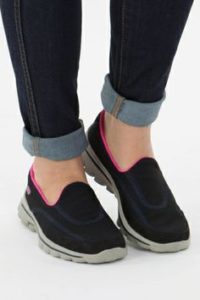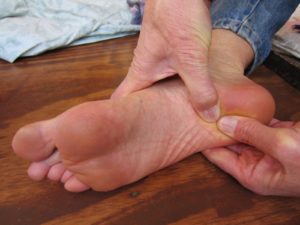Podiatrist advice for walking shoes – How to keep your feet happy

If you want to keep walking and stay mobile, you have to keep your feet happy. So you need a good pair of walking shoes and some good podiatrist advice. Here’s a summary of what we found:
Remember, our feet are our the foundation of the entire body. If there is instability down in your feet you’ll have issues further up into your legs, hips and lower back and even into the neck.
But it’s also a two-way street – if there is instability around the core/pelvis then this will put undue stress on the lower leg and feet.
If you over-pronate, make sure you find a shoe with sufficient arch support.
Over-pronation occurs when the ankle rolls too far down and inward with each step, causing the arch to collapse. When that happens, the muscles and supporting structures to overstretch and lengthen. Not only that, it also causes the pelvis to tilt forward, which can cause an increased curvature of the lower back.
Over time, over-pronation can lead to heel pain, shin pain, knee pain, lower back pain and a whole host of other issues. Shoes with orthotic technology built into them control the internal rotation of the shin bone and the rotation on the knee and hip joint. This reduces stretching and frictional forces on the muscles.
If you have stiffness in your big toe joint, find a stiff-soled shoe.
Stiffness in the joint can be a sign of early arthritis and the joint will become progressively more stiff over time. A stiff-soled shoe, which is curved upward toward the toes (rocker sole), can help in more advanced cases. Podiatrist advice for walking shoes is also clear on this: Orthotics inside the shoe can help to reduce load and improve function.
Stretch and strengthen your toes and your plantar fascia. Podiatrists commonly recommend standing on a towel and gradually gather it up with your toes, kind of like a game of Hungry Hungry Hippos. You can then push it back out flat, and eventually you can try this with weights on the edge of the towel. He also recommends spreading marbles on the floor and picking them up with your toes.
Stand on a tennis ball. Put a tennis ball under the ball of your bare foot, and put all your weight on it. At first you may only be able to stand it for a few seconds, but grit your teeth and keep doing it. It’s a great way to break up all the crap that accumulates in the feet.

Also, sit on your feet, with your toes bent in, yoga-style. This is also a painful to start, but if you can work through it, your feet will be much better off.
Choose walking shoes that accommodate your arch type. Generally speaking, your feet fall into one of three categories:
- Neutral-arched feet. Your feet aren’t overly arched nor are they overly flat. Look for shoes with firm midsoles, straight to semicurved lasts — last refers to the shape of the sole and the footprint around which the shoe is built — and moderate rear-foot stability.
- Low-arched or flat feet. Low arches or flat feet may contribute to muscle stress and joint problems in some individuals, though there is not a direct correlation. If you have significantly flat feet, you may benefit from a walking shoe with a straight last and motion control to help stabilize your feet.
- High-arched feet. High arches may contribute to excessive strain on joints and muscles, as your feet may not absorb shock as well, especially if you perform a lot of impact or jumping activities. Look for cushioning to compensate for your lack of natural shock
We are not doctors and this site is not offering medical advice. If you have serious foot pain, see your physician.
